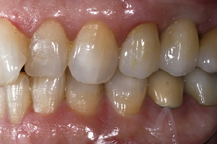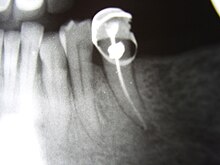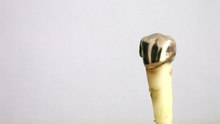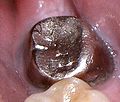Dental crown

The natural tooth crown ( Latin corona dentis ) is the part of a tooth that protrudes from the gums and is covered with tooth enamel , the hardest substance found in the human body. Derived from this, the term "crown" used in common parlance stands for an artificial tooth crown made of a precious metal alloy or ceramic . The visible part of a tooth is called the clinical crown.
The designation crown or tooth crown comes from the fact that the crown of a human molar , with the cusps that are approximately circular in plan view, resembles a royal crown .
The natural tooth crown
Every natural tooth consists of the tooth crown (Corona dentis), the tooth neck (Cervix dentis) and the tooth root (Radix dentis) and is made up of several layers. In a healthy tooth, you can only see the crown, which consists of the tooth enamel , which covers the dentin that lies inside like a glaze . The dentin in turn surrounds the pulp . Tooth enamel ( Latin : enamelum ) is the hardest substance in the human body with a Vickers hardness of 250 to 550 and a compressive strength of 300 to 450 MPa. Its modulus of elasticity is 50,000-85,000 MPa (Körber, 1995). Tooth enamel is made up of enamel-forming cells called adamantoblasts (also called ameloblasts ). It consists of 95 percent hydroxyapatite (Ca 5 (PO 4 ) 3 OH), a crystalline material, the main components of which are calcium and phosphates . Tooth enamel is slightly permeable to water-soluble substances, for example its components calcium and phosphate, as well as fluorides .
The crown is carried by the tooth root , which is anchored in the bone. The transition from the tooth crown to the tooth root is called the tooth neck .
If, in the event of pathological changes (e.g. inflammation of the gums ( periodontitis ), but also in the case of non-inflammatory atrophy (periodontitis) of the gingiva ), the bone that holds the tooth as a whole recedes, the part of the tooth that extends visually becomes longer protrudes from the bone.
The artificial crown
For an artificial crown, the natural tooth crown is prepared, that is, it is ground cylindrical or slightly conical up to approx. 1 mm below the gum line. A step, usually in the shape of a hollow, is placed on the neck of the tooth. The chewing surface or incisal edge also has to be sanded down enough that there is enough space for the opposing bite. This tooth stump prepared in this way is molded using a special molding compound ( silicone or hydrocolloid ). With the help of this impression, the dental technician can then create a working model on which he can manufacture the crown.
Until the dental work has been completed, the ground tooth must be protected against thermal and chemical stimuli as well as against a change in position by a provisional crown (mostly made of plastic) that is as well supported as possible proximally and occlusally and that fits cervically, with a relatively soft, easily removable crown Fixing cement is glued to the tooth stump.
Artificial crowns can on tooth stumps, post and core , but also on dental implants are incorporated.
If there is still enough remaining hard tooth substance, the tooth stump can be completed by means of a build- up. In other cases, a post abutment can be anchored in the root canal. Surgical crown lengthening can be carried out for deeply damaged teeth .
Abrasive tools with diamond coatings for turbine or contra-angle handpiece . The colored rings mark the grain size.
Prepared tooth stumps of teeth 11, 14 and 16 with chamfer preparation below the gum line
Fully veneered splinted crowns on teeth 24, 25 and 26 on the working model
Full cast crown, molar , gold alloy
Defective, because proximally perforated crown with completely inadequate occlusal surface modeling
same patient with longer crown margin, but dark gingiva due to dark root after ESR
materials
Metal-based crowns
The metal-based crown can be made of a high-quality gold alloy , a gold-reduced alloy , titanium or a non-precious metal alloy (NEM). With the cheaper gold-reduced alloys, the addition of less noble metals, such as palladium , can lead to allergies or discoloration of the oral mucosa. Therefore, in addition to the expensive “high gold” alloys, non-precious metal alloys, biocompatible non-precious metal alloys or titanium were developed as an inexpensive alternative.
The metal-based crowns can be manufactured as unveneered full cast crowns, partially veneered crowns or fully veneered crowns . The veneering material can either be a composite- based veneering plastic (i.e. a mixture of a resin matrix and ceramic fillers) or ceramic (veneering metal-ceramic - VMK). The latter require special due to the high baking-(800-900 ° C) ceramic alloys, which a bonding oxide layer (during the firing process adhesive oxides form). Ceramic veneering is more complex, but compared to plastic veneering it has the aesthetic advantage of better color stability and greater resistance to abrasion . However, this can also be a disadvantage, because its enormous hardness prevents even abrasion ( natural grinding ) and the antagonists (opposing teeth) are disproportionately "chewed off". The result can be TMJ problems .
Electro-gold based crowns
Crowns with galvanically separated basic frameworks occupy an intermediate position . These are produced electrochemically from pure (999) gold at room temperature and veneered in the color of the tooth. They combine very good body tolerance, accuracy of fit and high aesthetics, but are more prone to processing errors.
All-ceramic crowns

Instead of a metal framework, all-ceramic crowns usually have a core that is then burned over. The core can be milled from zirconium oxide on a CNC drilling and milling machine and is then veneered with ceramic. There is also the option of pressing the crown exclusively from ceramic from liquid ceramic at high temperatures (press ceramic ). Further veneering is no longer absolutely necessary, but offers advantages for the production of translucency and opalescence . In this way, a natural color effect can be reproduced. All-ceramic crowns cause fewer thermal stimuli due to their lower thermal conductivity.
Historical types of crowns
Ribbon crown
The band crown was a type of dental crown used in the past. A metal band was placed around the prepared tooth stump, the crown itself mostly consisted of a gold alloy.
Ring lid crown
In the earlier common ring-lid-crown , a ring for the side walls was first soldered from a piece of sheet gold that had been cut to size. The dentist then modeled a matching chewing surface in the mouth, the "lid", out of wax, cast it by the dental technician and then soldered it onto the prepared ring. The disadvantage was that the tooth equator was not at all or only weakly pronounced . The walls of the ring lid crown were practically parallel in vertical extension. A tooth equator was faintly indicated using special pliers ("humpback pliers"). The second major disadvantage was the poor crown marginal fit. The dental technician adjusted the crown margin on the gingival margin according to the plaster model. What then did not fit on the patient, the dentist made fit. Because a visual inspection was not possible, the edge of the crown often cut deep into the gum line and destroyed the attachment. Compared to today's casting technology, the edge gap was several orders of magnitude larger.
Stamped crown

A production method for crowns that was still widespread in Russia for a long time was the punched crown (“Sharpey crown”). From pre-assembled sheet metal sleeves (made of steel) - a ring with a cover available in approx. 10 different diameters - the appropriate diameter was first created with the help of a very stable mechanical special press. Several successive “pressing processes” compress the sleeve exactly to the required diameter. The principle is similar to wire production, in which a thick wire pulled through a nozzle that is a little too narrow becomes longer and narrower. The prefabricated crown sleeves were pressed through a hole that was a little too small using a sturdy punch that reached into the sleeve and was attached to a lever about 1 m long. The press holes were chosen to be smaller and smaller, up to the desired diameter. The length of the crown was adjusted - as with the ring lid crown - on the plaster model by eye - using crown scissors and hump nippers . The following method was used to provide the occlusal surface with a chewing surface profile (cusps and fissures): A tooth was modeled in wax on the plaster stump, whereby it was only the modeling of the occlusal surface that was important. The tooth model was not allowed to have a pronounced tooth equator on the sides. A plaster cast was taken from this wax crown together with the individual plaster stump of the tooth, and then poured with a low-melting metal (tin alloy; melting on the Bunsen burner). This resulted in a fully modeled tooth in solid metal (tin alloy), which later served as a patrix (positive, raised father shape ). A massive counter-mold was cast from the male mold: a thin separating film was applied to the female mold and a cast was made with the easily melting metal alloy. This second metal block later served as a die (recessed, negative mother mold ). The surrounding die could only be detached from the partially enclosed male by splitting the die into three parts at three predetermined breaking points. The pre-treated sleeve (diameter and crown margin made to match) was then pushed over the matrix. The three-part patrix was placed over the sleeve - everything is done in a funnel-shaped "assembly ring". The chewing surface of the sleeve was then formed between the female part and the male part with very strong hammer blows. The disadvantage of the method is that it was not possible to model any sharp cusps or sharp fissures. In addition, the sleeves on the edge of the crown are circular, which almost never corresponds to the actual shape of the tooth stump. Correspondingly, there are often relatively large gaps in the crown margin, which in practice are often surprisingly caries-resistant and which are bridged by the luting cement. Such crowns can also be made from gold sleeves, which significantly reduces the effort required. The gold crowns still worn en masse by Russian repatriates indicate this type of production: they have only a weakly indicated modeling of the occlusal surfaces and often a large marginal gap. The gold crowns are made from a very thin sheet of gold and are therefore partially transparent on X-ray images. The crowns were mostly made from the patient's own gold and not from special dental gold alloys, as is common with cast crowns.
The stamped gold crowns can also be used to make bridges - a gold crown is created for each bridge pillar. The individual bridge spans are cast separately in gold. At the end everything is soldered together. Such soldering points are weak points in this bridge construction because they often cannot withstand the forces that occur, they quickly discolor and occasionally come loose.
The gold crowns were also made on a large scale for decorative purposes for completely healthy front teeth (upper jaw). ("Those who can afford gold teeth are wealthy.") Currently, wearing individual gold crowns for jewelry purposes is also popular with African Americans in the United States . Other modern forms of tooth jewelry are twinkles (gemstones, gold applications) and grills in hip-hop culture . Until the appearance of tooth-colored fillings for the anterior region, it was fashionable (or at least not offensive) in Germany to wear a visible cast gold filling (inlay) to repair defects in the anterior region (often with a corner structure). The first tooth-colored fillings - silicate cements - were mechanically rather unstable and also washed out slowly. Only with the advent of tooth-colored composite fillings did visible gold inlays go completely out of fashion.
The Russian gold crowns only require little effort for the dentist to prepare the tooth stump. Only a small part of the tooth enamel is ground away, just enough that the tooth equator disappears. Often not even that completely, which is why the crown margin must then inevitably protrude somewhat from the tooth neck. Also between the teeth and on the chewing surface very little has to be ground away - just enough for the thin gold sheet to fit in between. Under pressure to assimilate and as an expression of their efforts to integrate , many Russian repatriates try to have their gold crowns exchanged for tooth-colored crowns. Amazingly, the tooth stumps under the gold crowns are sometimes only ground so weakly that they do not necessarily have to be crowned.
One advantage of punched crowns is that the dental technician only needs very little technical equipment - a very important criterion for free medical care in the Soviet Union. In addition, much less (precious) metal is required for stamped crowns than for cast crowns .
See also
- Partial crown (gentle variant of the crown for extensive tooth hard tissue defects)
- dentures
- Dental technology
- Bridge (dental technology)
- Evaluation standard for dental services , BEMA numbers 20a, 20b, 20c and 91a, 91b, 91c, 91d
- Tooth jewelry
- CEREC
- For animal teeth, see tooth formula
Web links
swell
Individual evidence
- ↑ Peter Pospiech: The prophylactically oriented supply with partial dentures: 7 tables . Georg Thieme Verlag, 2002, ISBN 978-3-13-126941-6 , p. 146- ( google.com ).
- ^ Hoffmann-Axthelm: Lexicon of Dentistry , Quintessenz-Verlag, Berlin
- ↑ Dissertation LMU, 2006, Jörg Bark, quantification of dentin abrasion on human teeth (PDF; 2.2 MB)
- ↑ Hermann Böttger, Horst Gründler: The dental and dental technology procedure for the telescope system in prosthetics: telescope crowns, bars, attachments, joints, bolts and the peripheral areas of the precision mechanical fastening devices . Verlag Neuer Merkur GmbH, 1982, ISBN 978-3-921280-23-2 , p. 57– ( google.com ).
- ↑ Manufacture of all-ceramic crowns [1]












